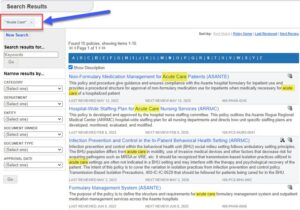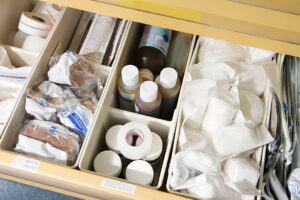Share:
DNV expected to make unannounced visit this summer or fall

Asante’s DNV accreditation survey is quickly approaching, with surveyors arriving possibly as early as August. This is a short turnaround from our previous survey in February, which was a makeup survey due to delays caused during the pandemic.
Unlike the February survey, the upcoming visit will be in-person and unannounced. Putting the work in now is the best way to prepare.
To help Asante be DNV-ready every day, the Accreditation team has partnered with leaders to conduct quarterly DNV prep rounds. These rounds consist of a basic physical environment evaluation and a review of key safety items, such as medication safety, expired or outdated products and equipment, and general infection control concerns.
Since these surveys are a team effort, you may wonder what you can do to help prepare. First, be familiar and comfortable with your area’s key processes and any improvement projects. DNV frequently engages with staff and may ask questions specific to your workflows, improvement projects and how you impact the community. We encourage you to share your stories, the things you and your department are doing to provide high-quality care, and what makes your area and the care you deliver special.
Other key items to be familiar with include:
Fire safety
- Understand the initials RACER (rescue, alarm, confine, extinguish, relocate) and PASS (pull pin, aim, squeeze and sweep). Asante Code Red Fire Response Plan 400-PE-0001.

- Know the location of fire alarm pull stations.
- Know where the fire extinguishers are in your workspace.
- Know the location of smoke compartments.
Environmental assessment
- Locate your nearest eye-wash station.
- Know how to access the MSDS for hazardous chemicals.
- Keep fluid warmers within the correct temperature range of 95 to 104 degrees F. Blanket and Fluid Warmer 400-PE-0502.

- Keep blanket warmers with a max temperature setting of 140 degrees F. Blanket and Fluid Warmer 400-PE-0502.

- Ensure your environment is clean and uncluttered.
- Move any items that may block fire exits, corridor fire doors, fire extinguishers or fire alarm pull stations.
- Make sure hallways are clear of beds or equipment, including mobile computer carts not in use.
- Properly store and secure oxygen tanks.
- Do not store clean items in dirty utility rooms and make sure there is a process to remove or clean any items that are placed in there. This includes equipment, broken equipment, used instruments, etc.
- Make sure all patient food and drink are correctly labeled and stored in designated areas. This should include a patient identifier and date. Room numbers should not be used as a patient identifier.
- Store your food in staff refrigerators.
- Make sure items in your storage areas have at least an 18-inch clearance from the ceiling.
Infection prevention
- Practice appropriate hand hygiene.
- Implement and follow any needed special precautions.
- Follow enteric precautions when indicated for C. difficile infection.
- Do not use tape on medical equipment or furniture.
- Do not store items under sinks.
- Inspect high-risk, low-utilization carts and areas for outdates.
- Wipe down equipment between each patient.
Document control
- Do not copy or use copies of documents. Always visit myAsanteNET for current documents.
- Documents posted in the department must be current and controlled.
- Any reference or training materials (or equipment) must be labeled.
To learn more, visit the accreditation page![]() on myAsanteNET.
on myAsanteNET.
If you have a question, please contact the author or relevant department directly.



